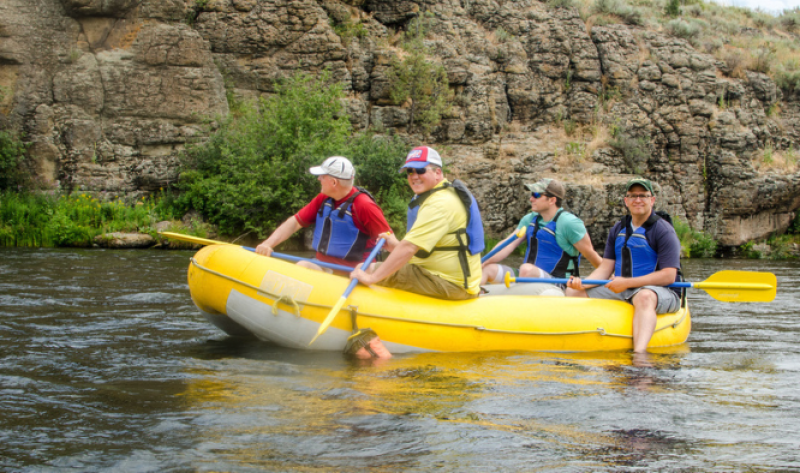Low Head Dams - The Drowning Machine
Low Head Dams may look peaceful but most recreationists are not aware of the serious risks associated with them.
An obvious danger is encountered when a boat is carried downstream over a dam, yet the most serious danger occurs immediately below the dam, where hydraulic effects can submerge a person or a vessel and keep it submerged within a few feet of the dam. Also, a person can become entangled in underwater debris, and not be able to free themselves.
Low-Head Dam Diagram

Boats that approach a dam too closely from downstream may actually be carried toward the dam by the reverse current. Once caught in the rotating current below the dam, it is very difficult to escape.
A cautionary statement to anyone floating Idaho rivers and streams:
Know the river area you are going to float BEFORE you float! Fremont County alone has thirteen hazardous low-head dams, five on the Snake River, four on Fall River, and four on Teton River. These low-head dams are unforgiving and dangerous, and under no conditions should individuals attempt to go over them during any time of the year. Water recreationists must learn all the dangers of the streams, rivers, and low-head dams. Anyone who uses these water sources should determine beforehand where these dams are and avoid them.
Why the Danger?
- Dams are difficult to spot from upstream and often are not marked by signs or buoys
- Dam hydraulics are unpredictable
- Dams can deceive even experienced boaters
- Areas immediately downstream also present risk as the water is flowing upstream
- Rescuing trapped individuals is dangerous and often unsuccessful
Safety Tips:
- Scout the river and know the location of hazards
- Boat with experienced, responsible boaters and learn from them
- Watch for a smooth horizon line where the stream meets the sky
- Look for concrete retaining walls which are part of the dam structure and easier to spot
- Portage (carry your watercraft on land) around all dams
- When portaging, re-enter the river at a point well downstream of the backwash

In reference to hydraulics and low head dams, Department Chair of Recreation Management, Brother Scott Wood referred to a story of Tannin Martino, a student killed on the Snake River three years ago. He was Brother Wood's executive secretary who hadn't been to church in a few weeks. When he looked into the situation, he was informed by Search and Rescue that Tannin had drowned at a low head dam called Chester Dam. He had been floating on inner tubes with a few friends. When his friends tried to get out of the water before the dam, Tannin refused and said, "I'm going for it!" The deception of the calm water before the dam gave the appearance of it being safe. He was "maytaged" by the water and caught in the washer-machine, tumbling effect that would not release him. His body was recovered a few hours later. The problem with inner tubing down rivers is that it takes no skill at all and rivers aren't properly evaluated before hand.
Water Danger
Bridge Jumping/Diving - Deaths and accidents occur every year because of this activity. A specifically dangerous place is the Funny Farm Bridge, a popular place for both bridge jumping and bridge diving. One student dove here after he and his friends had been diving for a long time. On his last dive, Josh smashed his face, broke his neck, and now must breath with the assistance of a device through a hole in his neck.
When the water is high, it will carry you when entered. Even the strongest swimmers don't do well in fast currents and can be swept away. Another factor that must be taken into account is the temperature of the water. Idaho water is usually extremely cold from snow runoff and can cause the body to cramp up, go stiff, or go into hypothermia.
In Brother Wood's words, "It's not a bad thing to take a risk when skill is involved. Calculated risk is a good thing, but to take a risk without the skill necessary is pure stupidity. The consequences not only hurt the person involved but others as well."
Prevention:
Be prepared. Don't assume you're a guide from only a few experiences. Don't do more than your body can take.
Brother Wood has said, "A good indication that you need to stop is if you can't stay up with the group, are having a hard time breathing or thinking, or hot spots or blisters appear." All these factors are red flags.
Potential errors:
- Desire to please others
- Trying to adhere to a schedule
- Misperception
- New or unexpected situations
- Fatigue
- Distraction
- Mis-communication
- Disregarding instincts
German philosopher, Kurt Hahn states, "The bravest man is the one who weighs up all the risks and when they have become greater than the object is worth, has the courage to turn back and face the other risk of being called a coward."
Nephi took risks WITH THE SPIRIT to guide him. 2 Nephi 25:23 "...for we know that it is by grace that we are saved, after all we can do."
Our goal in the Safety Council is not to prevent risks and prevent trying new things in the outdoors and expanding experiences and talents. Our goal is to educate students to do so safely.